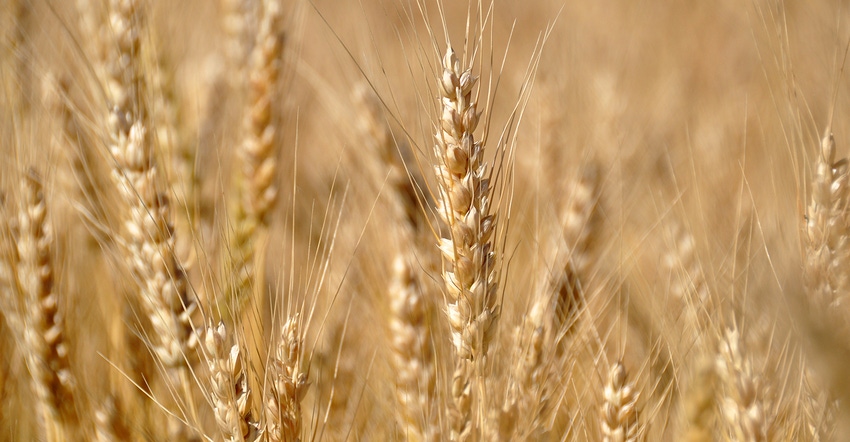
Spring wheat was trying to move back to $8 in late July as condition ratings for the crop in the Northern Plains continued to decline and forecasts for 100-degree-F heat there weeks before the late-summer harvest added to the bullish ideas.
Customs harvesters expect the worst for the spring wheat in central and western North Dakota and in Montana when combines start rolling in August. The crop along the Red River in the east is said to be in decent shape.
The return to $8 was hampered by USDA increasing U.S. winter wheat production and forecasting plentiful world supplies in its mid-July report.
USDA bumped up winter wheat production 2% to 1.28 billion bushels from the June forecast on ideas the crop will yield 49.7 bushels per acre, the second-highest yield on record. USDA raised yields for Colorado, Idaho, Illinois, Kansas and Missouri, among others.
In August, winter wheat should be largely harvested, and the spring wheat harvest will be beginning. While yields and harvested acres for spring wheat are widely expected to be down across the Northern Plains, particularly in the Dakotas and Montana, the actual results should be known about now.
Spring wheat continued to deteriorate in late July amid the hot, dry conditions in the Northern Plains. USDA rated the crop 34% good to excellent, with declines noted in Idaho, Minnesota and the Dakotas. The lower rating took an estimated 0.8 bushel off the average yield, says Bryce Knorr, Farm Futures senior grain market analyst.
“That takes the average yield down to 36.9 bushels per acre, in a range from 36.5 to 37.3 bpa. USDA forecast the yield at 40.3 bpa, suggesting the total all-wheat crop is down to 1.731 billion bushels, with spring wheat 27 million bushels less,” he says.
USDA also lowered world wheat production a little in that July report because of problems in the U.S., Europe and Australia, but its ending stocks number of 260.6 million metric tons is still plenty, and up from the previous year’s 258.5 million metric tons.
Winter wheat harvest
Custom wheat harvesters in western Kansas and eastern Colorado found better-than-expected yields and grain quality in July on fields that escaped disease or a June hailstorm.
There were still plenty of fields hurt by the weather or disease, but those that were missed yielded 40 to 70 bushels an acre, with test weights of 60 pounds a bushel or more. In addition, a number of harvesters report protein levels of 12% or higher.
“They have a good crop here, with 70-plus yields. The protein is good 11.5 to 13.5,” says harvester Short Kulhanek, who cut fields near Colby in northwest Kansas. “They didn’t get the big snow that the others got.”
A late April snowstorm hit western Kansas and laid much of the wheat down. Harvesters say some of that wheat recovered and is producing better-than-expected yields. Also, a hailstorm in late June in eastern Colorado and northwest Kansas damaged a number of fields.
“The wheat is above expectations. It is probably running in the 40- to 60-bushel range,” says harvester Chad Brink, who cut near Dighton in western Kansas.
Not all of the crop news is good. Many areas in Kansas are infested with wheat streak mosaic that either wiped out fields or greatly reduced yields. “Wheat streak mosaic is a huge issue here. It just wiped some fields right out,” says Brink.
Harvesters in eastern Colorado report better-than-expected yields and grain quality.
“Cheyenne Wells has a pretty good crop. There is a lot of variation on protein; there is a lot of 11% and some 12%,” says harvester Mike Strunk.
Further west and closer to Denver, disease or weather reduced yields, Strunk adds.
Farmers are reluctant to sell their wheat despite the recent sharp rise in wheat prices this summer.
“I think for the most part, the farmers are holding on to it,” says Brink. “They think prices will go higher with the fewer acres and not good crops in Nebraska and the Dakotas.”
A common complaint from the harvesters is fewer wheat acres this year. Farmers either planted less wheat or plowed up poor-emerging fields and replanted them to corn or other crops.
“There are a lot more corn and soybeans,” says Irvin Odegard, who harvested in eastern Colorado.
USDA’s July production report confirmed those sentiments. That report put harvested acres in Kansas at 6.9 million versus 8.2 million a year. Colorado was expected to harvest 2 million, down from last year’s 2.19 million, and Nebraska 1 million versus 1.31 million a year ago.
Summer heat wave
Much has been written about the heat wave in the Northern Plains. The National Weather Service report on July 18 detailed some of the record-setting hot weather:
“In the drought-stricken northern High Plains, temperatures frequently topped 100 degrees F and averaged as much as 10 degrees above normal. Hot weather [temperatures at least 5 degrees above normal] also extended southward through the nation’s midsection and across most of the Western U.S.”
The intense heat covered the north-central U.S. Nebraska had record highs for July 9 of 109 degrees in Valentine and 107 degrees in Chadron. “For Valentine, it was the highest reading since July 23, 2012,” according to the NWS report.
In Montana, the report said daily record highs on July 9 included 99 degrees in Great Falls and 97 degrees in Lewistown. After a brief break, heat later returned across the Northern Plains, where Dickinson, N.D., had a daily record high of 104 degrees on July 14.
The heat was not just confined to the Northern Plains, as McAllen, Texas, also logged a daily record high of 104 degrees on July 14. Farther east, a spell of record-setting heat in the mid-Atlantic states resulted in a daily record-tying high of 98 degrees on July 12 in Richmond, Va.
Burgdorfer is senior editor for Farm Futures.
About the Author(s)
You May Also Like




